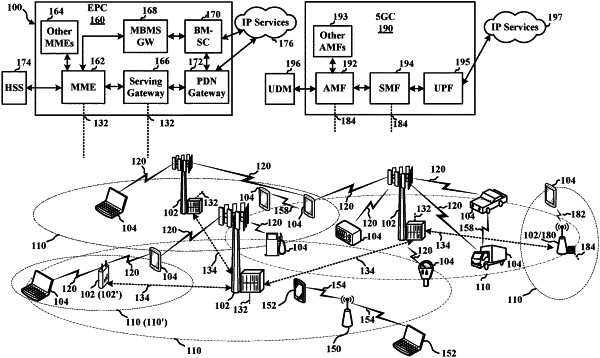| CPC H04W 36/08 (2013.01) [H04W 36/12 (2013.01); H04W 74/0833 (2013.01); H04W 76/14 (2018.02); H04B 7/155 (2013.01); H04W 84/042 (2013.01); H04W 92/045 (2013.01)] | 30 Claims |

|
1. An apparatus for wireless communication, comprising:
a transceiver;
a memory configured to store instructions; and
one or more processors communicatively coupled with the memory and the transceiver, wherein the one or more processors are configured to execute the instructions to cause the apparatus to:
receive, by a mobile termination (MT) function, a first indication to migrate from a first IAB donor node that serves the apparatus via a first cell group provided by a first central unit (CU) to a second IAB donor node for serving the apparatus via a second cell group provided by a second CU;
perform, based at least in part on receiving the first indication, a first random access procedure to connect to the second cell group associated with the second IAB donor node;
establish, in addition to a first distributed unit (DU) function of the apparatus that provides a third cell group for serving one or more child nodes and based on performing the first random access procedure, a second DU function of the apparatus that provides a fourth cell group for serving the one or more child nodes; and
trigger, based on establishing the second DU function, a second random access procedure for a child node to migrate from the third cell group provided by the first DU function to be served by the fourth cell group provided by the second DU function.
|
|
25. A method of wireless communication, comprising:
receiving, by a mobile termination (MT) function of an integrated access and backhaul (IAB) node, a first indication to migrate from a first IAB donor node that serves the IAB node via a first cell group provided by a first central unit (CU) to a second IAB donor node for serving the IAB node via a second cell group provided by a second CU;
performing, by the IAB node and based at least in part on receiving the first indication, a first random access procedure to connect to the second cell group associated with the second IAB donor node;
establishing, by the IAB node in addition to a first distributed unit (DU) function of the IAB node that provides a third cell group for serving one or more child nodes and based on performing the first random access procedure, a second DU function that provides a fourth cell group for serving the one or more child nodes; and
triggering, based on establishing the second DU function, a second random access procedure for a child node to migrate from the third cell group provided by the first DU function to be served by the fourth cell group provided by the second DU function.
|